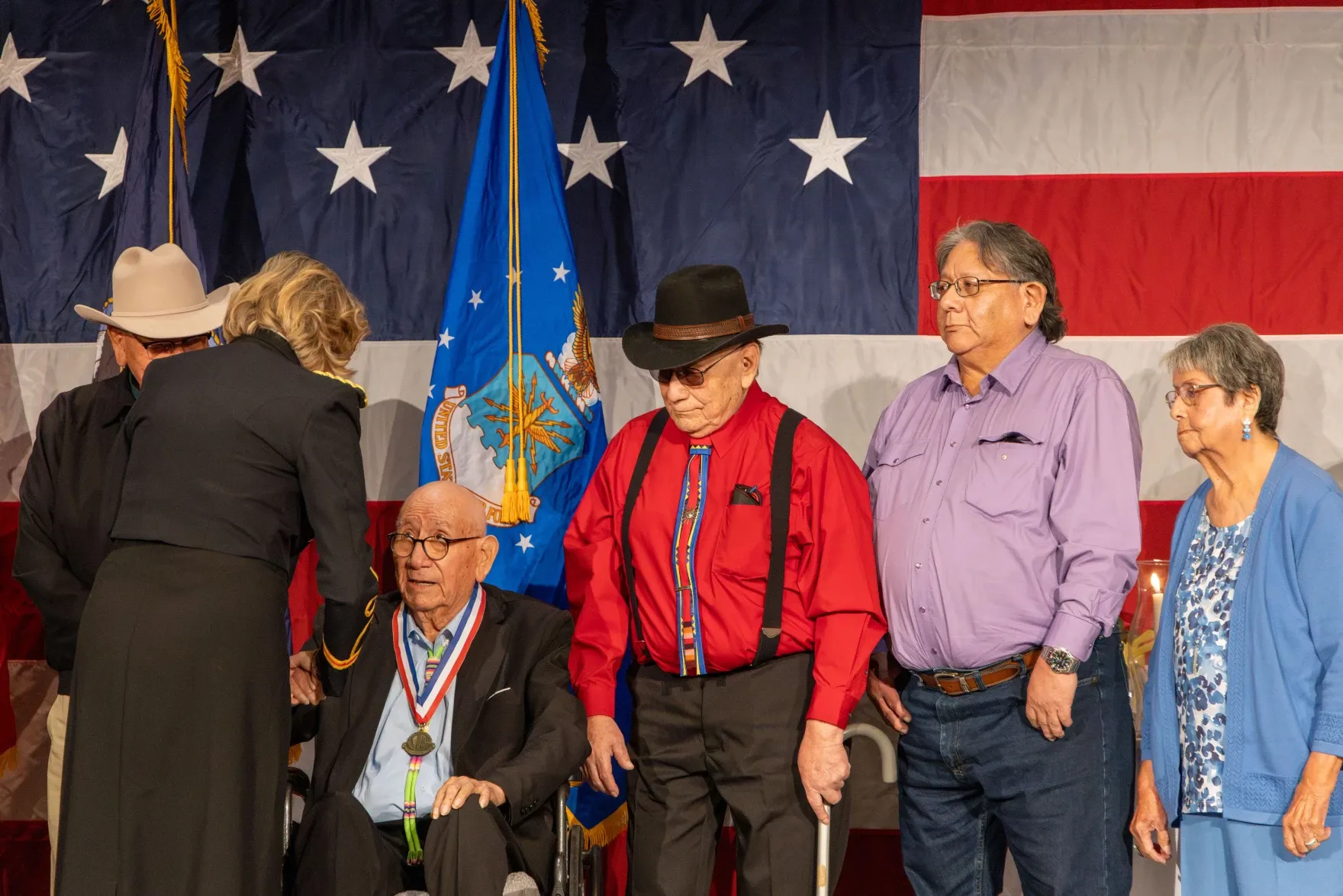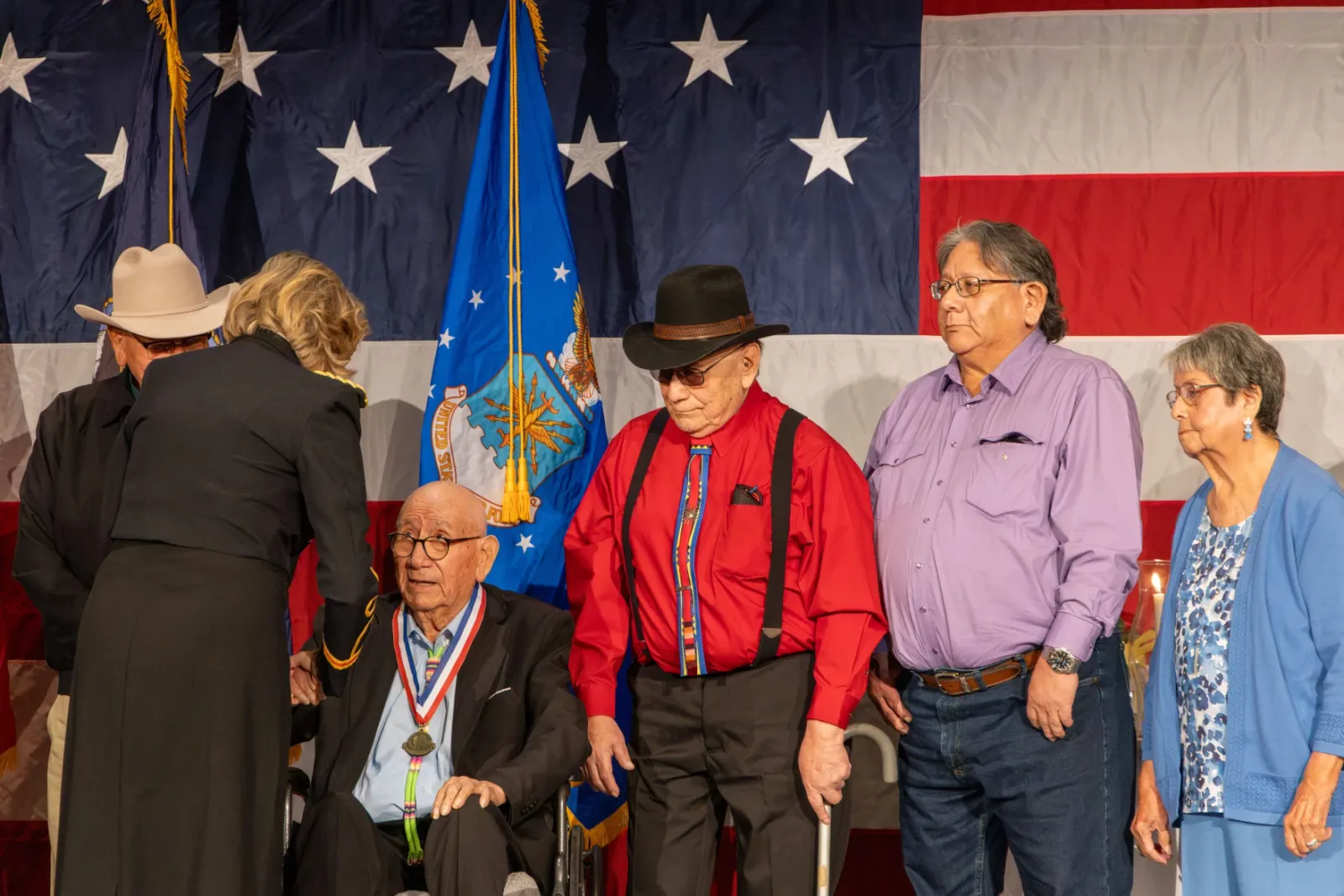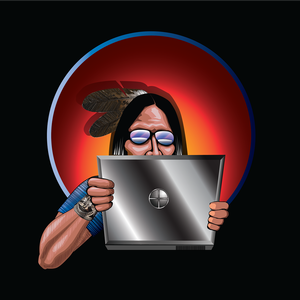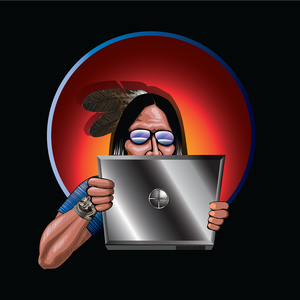

Kiowa Code Talkers inducted into Oklahoma Military Hall of Fame

The Oklahoma Military Hall of Fame inducted the Kiowa Code Talkers for their service in World War II, for their use of coded language, never cracked by enemy soldiers. There are four Indigenous code-talking groups honored by the Oklahoma Military Heritage Foundation: Pawnee, Choctaw, Comanche and now, Kiowa.
By Sarah Liese (Twilla) KOSU
Three Kiowa Code Talkers received state recognition for their service 80 years ago in World War II at the Oklahoma Military Hall of Fame's 26th annual banquet: Private First Class Leonard “Red Wolf” Cozad Sr., Private First Class James Paddlety Jr. and Private John Tsatoke.
None of the code talkers were alive to witness this induction ceremony on Nov. 1, Kiowa Chairman Lawerence Spottbird said during the tribe’s acceptance speech.
“All these Kiowa legends are deceased,” Spottedbird said. “But their legacy as Kiowa warriors, the legacy of all of our Kiowa warriors, lives on today. …Thank you all for coming and recognizing this and standing with us, fellow veterans who have served proudly again to serve and protect this flag that's behind us so that we all can enjoy the freedom today.”
One of the three Kiowa Code Talkers honored was Leonard “Red Wolf” Cozad Sr. His son Daniel Cozad, whose Kiowa name is Sait-keen-Tahay or Bear Shield, said he learned his father was a code talker after his death.
“We didn't know until the United States Congress recognized it that they got hold of us and told us about it,” the younger Cozad said. “So I figured that, you know, it was an order that never to be broken.”
Cozad said now his father’s legacy as a Kiowa code talker is a point of pride for his family, as well as the songs he created after serving his country. He explained that a pivotal moment in his dad's life occurred when he was injured at war.
“He said, I don't want to die here in foreign soil,” Cozad said. “I want to go back home. … and he was praying and he said I want to do something for our people. So when he came back, our daddy, he was a composer of our tribal songs.”
Cozad couldn’t put a number on how many songs his father composed. But he said they continue to be sung by his descendants and others, such as the Kiowa Black Leggings Society, a Kiowa veterans society for their male citizens.
“He left a legacy,” Cozad said. “That's what we try to carry on. …To sing these songs are for the people. And that's what this is all about.”
Code Talker history
Bill Meadows is a professor of anthropology and Native American studies at Missouri State University. He advocated for the induction of the Kiowa Code Talkers into the Oklahoma Military Hall of Fame. Before that, he helped get the 2008 Native American Code Talkers Act passed by testifying before Congress. The act recognizes code talkers, or Native Americans who used their respective languages to send secret wartime communication.
Meadows’s research has led him to identify about 35 different tribes that had code talkers. Some had more formal training, he said, such as the Navajos and Comanches; however, more groups did not have a formal code list, which he noted worked just fine.
“Most of these languages, Native languages at this time, were not written,” Meadows said. “There was nothing published. So you couldn't go to a library in Berlin or Paris and pull anything out.”
Among Oklahoma tribal nations, Meadows said there were Choctaw, Cherokee and Comanche code talkers in World War I, as well as references to Osages. As for World War II, he named Muscogee, Seminoles, Choctaw, Kiowa and Pawnees.
“It was cutting edge,” Meadows said. “It's a fairly simple idea in hindsight, but it was cutting edge.”
Ironically, the vast majority of the code talkers attended boarding schools, Meadows said. Leonard “Red Wolf” Cozad Sr. went to a small Southwest Oklahoma day school and was punished for speaking his language, according to his son. But he continued to speak his language fluently and served as an inspiration to his family. Even the next generation.
“That was a time when there were policies to eliminate our language,” said Dustin Cozad, a grandson of Leonard Cozad Sr. “But yet at the same time, it was our language that helped save our country during a critical time.”

Comanche Nation Entertainment Partners with First Nations Experience TV

Bringing Indigenous Storytelling to Hotel Guests
DEVOL, Okla. — Comanche Nation Entertainment has announced a groundbreaking partnership with First Nations Experience (FNX), the only national broadcast network devoted to Native American and World Indigenous programming. Through this collaboration, the FNX App will be preinstalled on all in-room Smart TVs at Comanche Red River Hotel Casino, giving guests convenient access to a rich library of Indigenous stories, cultures and perspectives.
The partnership began at the Indian Gaming Association conference in San Diego, where FNX representatives introduced their broadcast channel and streaming app to tribal enterprises nationwide. During the event, discussions between FNX and Comanche Nation Entertainment representatives led to a shared vision of expanding Native representation through accessible media.
“Our new partnership with the Comanche Red River Hotel Casino is a pivotal moment for us that represents a first-of-its-kind agreement with a tribally owned and operated facility,” said Frank Blanquet, Producer and Director at FNX. “We’re humbled and grateful for the Comanche Tribe’s trust in establishing this inaugural alliance.”
Guests at Comanche Red River Hotel Casino will soon find the FNX App directly on their in-room TVs, allowing them to stream programs that celebrate Indigenous communities, from documentaries and cultural features to contemporary entertainment.
“Comanche Nation Entertainment is proud to provide our guests with programming that honors Native heritage and storytelling,” said Julius Kazen, Director of Non-Gaming at Comanche Nation Entertainment. “This partnership reflects our continued effort to uplift Indigenous voices and share authentic cultural experiences.”
FNX, headquartered in San Bernardino, California, delivers content produced by and for Native and Indigenous peoples. The network’s programming includes documentaries, arts and culture features, children’s shows and educational series that reflect the diversity and vitality of Indigenous nations across North America.
“FNX Television works hard to earn the trust of Indian Country through a commitment to authentic and accurate Native and Indigenous storytelling,” said Blanquet.
This collaboration marks the beginning of broader opportunities for FNX to partner with other tribal nations, further expanding Indigenous representation in hospitality and entertainment spaces.
For more information about Comanche Nation Entertainment, visit www.comanchenationentertainment.com.
For more about FNX, visit fnx.org. For information about FNX partnerships contact Frank Blanquet at fblanquet@fnx.org or Manny Saucedo at msaucedo@fnx.org or call 909.384.4444
Native American Heritage Month Underscores Urgent Need for 988 Awareness in Tribal Communities

AAIP and Sac and Fox Nation continue collaborative effort to reduce stigma and promote mental health support among Native peoples
STROUD, OK – November is National Native American Heritage Month, a time to celebrate the culture, history and resilience of American Indians and Alaska Natives. It also offers an opportunity to raise awareness of critical health resources like 988 — the Suicide and Crisis Lifeline — as Native communities continue to experience disproportionately high suicide rates across the U.S.
The Association of American Indian Physicians (AAIP), in partnership with the Sac and Fox Nation, is marking the month by continuing outreach for its 988 Mental Health Lifeline campaign. Funded through a grant from the Substance Abuse and Mental Health Services Administration (SAMHSA), the initiative works to increase awareness and reduce stigma surrounding mental health care in Native communities. At the heart of the campaign is the message, “there is strength in asking for help,” reminding community members that reaching out in moments of struggle is an act of courage.
For generations, Native people have experienced collective trauma from displacement, discrimination and loss of land, realities that continue to shape mental health outcomes today. Persistent disparities in access to culturally informed behavioral health care, funding and services have only deepened these challenges. According to SAMHSA, every 11 minutes, someone in the U.S. dies by suicide, and Native communities have been especially impacted in recent years. In 2021 and 2022, suicide rates rose significantly among American Indian and Alaska Native people.
To better understand current attitudes toward mental health, the Sac and Fox Nation conducted a 2024 survey during its annual powwow. Nearly 67% of respondents identified fear of judgment or stigma as a barrier to seeking help, while 83% of respondents emphasized the importance of cultural understanding in crisis response.
AAIP’s 988 campaign launched in 2023 and features members of the Sac and Fox Nation in public service announcements (PSAs) and educational videos. These stories show community members speaking openly about moments of challenge and how finding help can make a difference, reinforcing that no one must face crisis alone. The effort has been recognized for its impact, earning two Upper Case Awards for excellence in public relations and public service communications at the PRSA-OKC 2025 award ceremony. Campaign resources and videos can be found at WeBelong988.com and on AAIP’s YouTube channel.
“The 988 Lifeline is a free resource available to all ages. If you or someone you know is having a hard time or struggling, reach out,” said David James, director of health services at the Black Hawk Health Center in Stroud. “It is important to talk to someone, and you can be connected to vital resources and support. Through this campaign, we are helping our community know that it’s okay to ask for help. We look forward to continuing to share this important resource and helping people to know they are not alone.”
The 988 Suicide and Crisis Lifeline provides 24/7, free and confidential support to anyone experiencing suicidal thoughts, substance misuse or emotional distress. It also serves as a trusted resource for those seeking to help family or community members in need. People can call or text 988 if they’re feeling overwhelmed, anxious, depressed or simply need someone to talk to. Trained counselors are ready to listen and connect callers to local resources when needed. Recent data finds that every month, Oklahoma’s 988 line receives between 7,000 and 8,000 calls, a number that continues to grow, reflecting the need for accessible crisis care.
AAIP’s 988 campaign highlights the organization’s mission to promote the physical, mental and spiritual health of Native peoples through education, prevention and culturally grounded communication. Through public service announcements, community events and educational materials, the campaign continues to empower Native individuals with the message that help is always available, healing is possible and there is strength in asking for help.
If you or someone you know is struggling or in crisis, help is available. Call or text 988 or visit 988lifeline.org to connect with a trained professional.
About the Association of American Indian Physicians (AAIP)
In 1971, fourteen American Indian and Alaska Native physicians endeavored to improve the overall health of their communities, and the Association of American Indian Physicians was born. Today, hundreds of licensed and practicing physicians nationwide are committed to that same mission. AAIP pursues excellence in Native American health care by advocating education in the health sciences and honoring traditional healing principles. In addition, AAIP members directly address widely acknowledged disparities in American Indian and Alaska Native health. For more information, visit aaip.org.
Strong female tribal examples helped forge career

Robin Lee Corley’s Chickasaw heritage was cemented at an early age as she absorbed the subtle lessons of strength she saw in her grandmother and her grandmother’s three sisters. Corley said their example helped lay the foundation for her eventual 39-year career working with the U.S. Department of Defense (DOD).
“I remember all of those women being very strong, not bossy or in a negative way, just really strong,” Corley said. “Their camaraderie never wavered. We spent a lot of time in Durant and Bokchito (Oklahoma) as part of that family cohesion and togetherness. That’s where I learned the matrilineal part of the heritage.”
Corley is set to retire from the DOD Sept. 30 of this year.
Corley’s extensive career serving her country makes her a fitting tribute to the relevance of observing Native American Heritage Month. The November celebration recognizes and honors the history, culture and traditions of First Americans, Alaska Natives and Native Hawaiians, and their contributions to the United States.
In 1986, the Oklahoma State University chemical engineering graduate’s employment prospects were not promising. Oil prices had plummeted and with them went the typical career opportunities in her chosen field.
It turned out there was one place to find employment, and it was at Tinker Air Force Base in Oklahoma City.
“I was very lucky I had a job. Because of the oil bust, no one in my graduating class was getting a job. Typically, when you graduate from Oklahoma State in engineering you go to a refinery or a fertilizer plant. I stumbled into aviation,” Corley said.
It turned into an occupational love affair that would last for nearly four decades.
“I love to talk about airplanes. I love aviation,” she said.
The desk in her last assignment at Naval Air Station Whidbey Island, Oak Harbor, Washington, gave her a bird’s-eye view of its flight line where she could watch flight operations.
“Airplanes were taxiing probably 40 feet from my window,” she said. “That was just a great gig. I was very lucky.
Her stint working for the Air Force lasted 16 years, after which she applied for a job in 2002 with the U.S. Navy while still at Tinker Air Force Base.
“From 2002 to 2009, I worked the E-6 Mercury (a communications relay and strategic command post aircraft) at Tinker,” she said.
“In 2009, I got married to a Navy Chief, and we moved to Whidbey Island. We supported all Growler (electronic attack aircraft) squadrons at Whidbey Naval Air Station. Again, I feel like the luckiest person in the world. I got the only airplane engineering position on what is a very tiny naval air station. I ran its engineering group.”
Corley said her team’s responsibility was to design the repairs, repair the corrosion and bring the aircraft back up to air worthiness standards.
“We did not have the luxury of time,” she said. “It was a very stressful job.”
Added to those responsibilities was periodic maintenance in which planes were disassembled and checked for deterioration. This work included excess Super Hornet jets from other Navy locations requiring overhaul.
“We would work on up to 50 airplanes a year just on periodic maintenance, designing repairs for those needing work. Often there was corrosion, excessive service wear, hail damage, bird strikes, anything that could keep an airplane structure from flying. We were responsible for returning it to service.”
Two days before Thanksgiving 2023, Corley was sent to Kaneohe Bay in Hawaii after a Navy P-8A Poseidon maritime patrol aircraft plunged off its runway in inclement weather. Her job was to not only help salvage the jet but to preserve the bay’s clean water.
“The airplane was sitting in approximately 30 feet of water on coral bed, full of fuel and hydraulic fluid in a very pristine environment. I worked for 17 days with a contractor, divers and a salvage team, and they pulled that plane out of the water. That’s something not everyone can say they’ve done – pull an airplane out of the water. It was an accomplishment, and I was a small part of it,” she said.
“My great-grandmother, Cora Jones, whose maiden name was Archerd, attended Bloomfield Academy and is on the Dawes Roll. I have a lot of things around my house to remind me of her. A huge painting she did is in my dining room.
“She would do all kinds of threadwork. I have pillowcases she embellished with very fine work. When I was 5, I got this little doll trunk, and she sewed me little doll outfits and made me matching outfits sewing on a Singer Featherweight sewing machine.”
An aunt originally gained possession of the sewing machine and gifted it to Corley.
“When my granddaughter turned 5, I pulled out the Featherweight and made my granddaughter matching doll clothes and outfits and gave them to her in the same little trunk. I feel like it is important to not let my granddaughter forget her ancestry and to make her aware of her First American culture.
“I worked in a man’s world and think my great-grandmother would find it kind of amazing from the perspective of her own era that a female could achieve the career I enjoyed. I don’t think I would have been as successful without the backdrop of those female relationships.”
Corley credits the Chickasaw Nation with helping her two sons achieve academic success. Her oldest, Cmdr. Kenneth Stearns, earned his Doctor of Pharmacy and is currently working with the Chemawa Indian Clinic, Salem, Oregon, under the auspices of the Indian Health Service.
Her other son, Korey Stearns, is a mechanical engineer working in Sallisaw, Oklahoma.
She said music is an important part of her life. She started playing the violin when she was 5 and currently plays with the Skagit Symphony in Skagit Valley, Washington, just east of Whidbey Island.
Her admiration for Chickasaw Nation Governor Bill Anoatubby runs deep.
“I always brag about Governor Anoatubby,” she said. “I think we are so lucky to have him. He is magical. I attended a Chickasaw event in Vancouver, Washington, and had a chance to meet the man himself. I think he should be President of the United States.”
Among the highlights of retirement Corley said is not having to rise as early as her career demanded.
“I no longer have to get up at four in the morning,” she said.
Corley also sees retirement as an opportunity to invest more time diving deeper into her Chickasaw heritage.
“I’m also going to continue my Rosetta Stone Chickasaw language and learn to make beaded collars from the recently released YouTube tutorial from the Chickasaw Nation Culture and Humanities channel,” she said.








